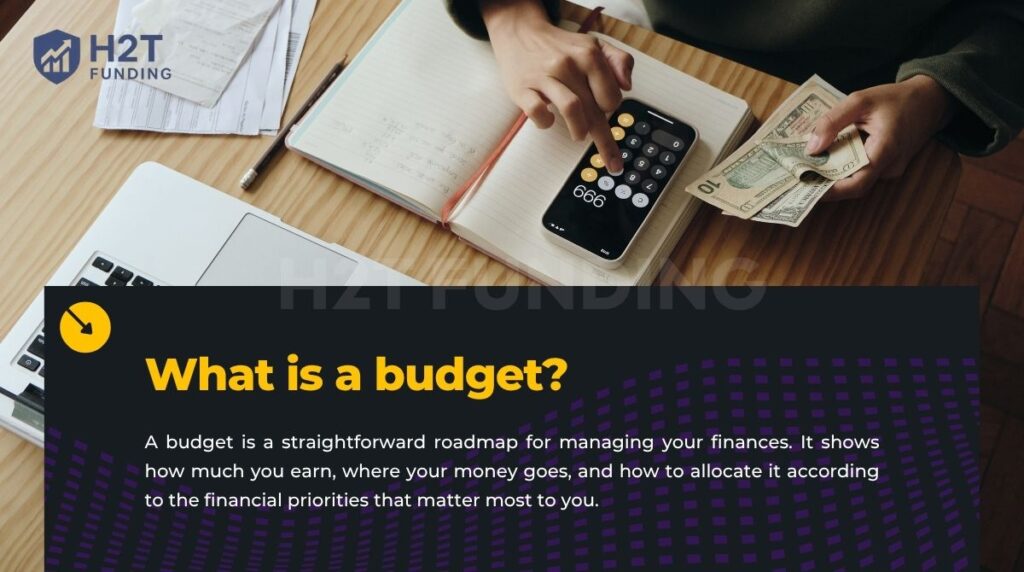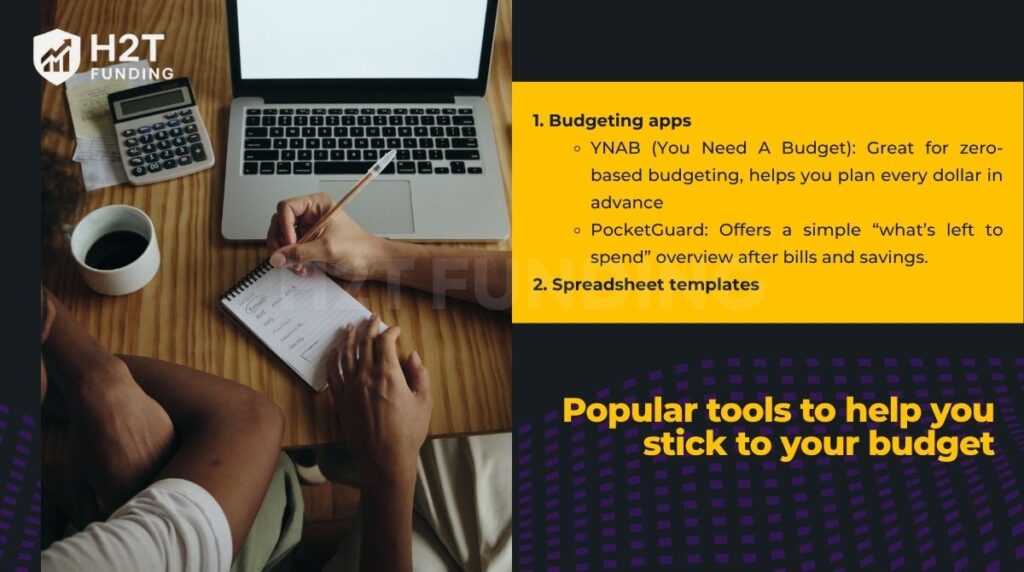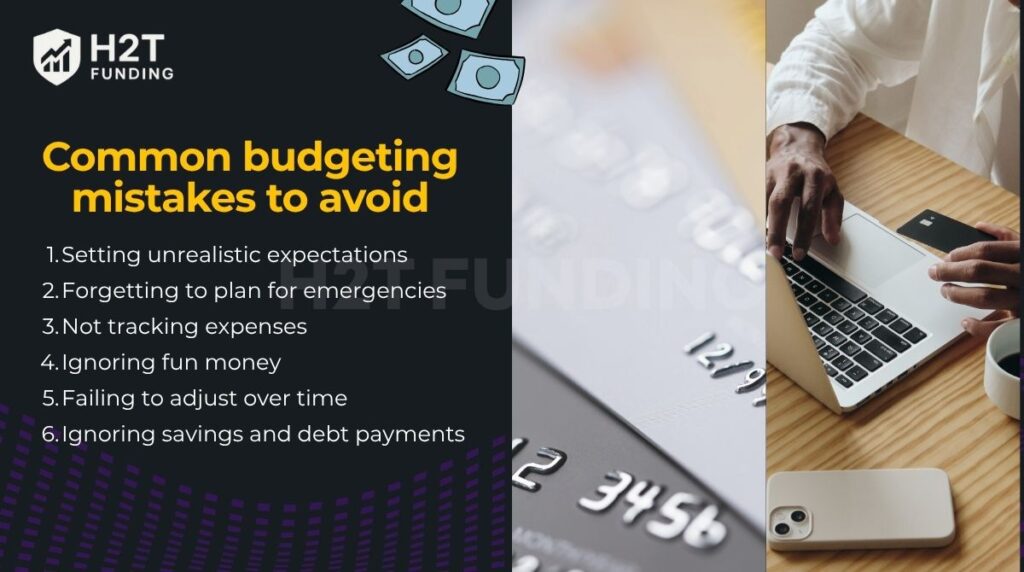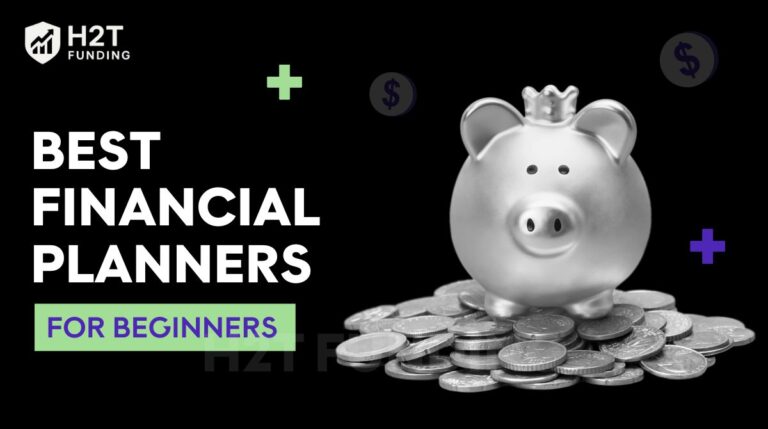Losing control over your personal finances can quietly build up into long-term stress. According to a 2024 LendingClub report, nearly 60% of Americans live paycheck to paycheck, even those earning above-average incomes.
So, if you’ve ever asked yourself how can I budget my money more effectively, this guide is for you. Instead of restricting your lifestyle, budgeting creates a real sense of empowerment by helping you make conscious decisions and take control of your future.
This guide will walk you through a practical 5-step budgeting process, designed for clarity, ease, and real-world use, so you can start managing your money with confidence today.
Key takeaways:
- A budget is a simple financial plan that helps you track income, manage expenses, and align spending with your financial priorities.
- Always track your income and expenses honestly to see where your money truly goes and prevent hidden deficit situations.
- Set clear short-term and long-term goals to stay focused and motivated when managing your money.
- Use flexible budgeting methods like the 50/30/20 rule or pay-yourself-first to build consistency and avoid burnout.
- Review your plan regularly, automate savings, and learn from past mistakes to keep improving your financial habits over time.
1. What is a budget, and why is it important?
A budget is a straightforward roadmap for managing your finances. It shows how much you earn, where your money goes, and how to allocate it according to the financial priorities that matter most to you. Like a GPS for your finances, it helps you see where you stand and guides you toward your financial goals with clarity and direction.

Many people associate budgeting with restrictions or cutting back, but the true purpose of budgeting is to give you financial freedom. Instead of guessing how I can budget my money better month after month, creating a structured plan helps me stay proactive, not reactive.
Whether you’re saving for a house, managing debt, or trying to break the paycheck-to-paycheck cycle, a good budget provides the foundation for informed decision-making.
Here’s why a budget is essential for anyone who wants to build a healthier financial future:
- Provides control: Every dollar has a purpose, reducing uncertainty and stress.
- Supports long-term clarity: Whether saving for a vacation, paying off debt, or building an emergency fund, a structured plan helps you work toward a meaningful financial surplus.
- Encourages smarter decisions: When you understand your daily costs, you can quickly identify spending leaks and make more intentional choices.
- Protects from financial shocks: Regular tracking of expenses and savings ensures preparedness for unexpected events.
One of my close friends used to ask the same question at the end of every month: “Where did all my money go?” She wasn’t a reckless spender. In fact, she didn’t think she spent much at all. But without a budget, the little daily purchases added up, such as takeout meals, streaming subscriptions, and random online shopping.
It wasn’t until she started tracking her income and expenses on a spreadsheet that she realized how disconnected she had been from her own money. Within three months of budgeting, she spotted several spending leaks and cut unnecessary expenses by 20%. She also saved enough to cover an unexpected car repair without using her credit card.
Read more:
2. How can I budget my money? The core 5-step process
Budgeting is a structured system that transforms how you manage income and expenses. To build a plan that truly supports your financial targets, follow this 5-step budgeting process designed for clarity, flexibility, and long-term success:

- Step 1: Calculate your total monthly income
- Step 2: Track your expenses to uncover real spending patterns
- Step 3: Define your “why” with clear financial goals
- Step 4: Choose a budgeting method that fits your lifestyle
- Step 5: Create your plan, then review and adjust it regularly
Let’s dive in to see how you can start budgeting effectively today.
2.1. Step 1: Calculate your total monthly income
The first step toward building financial capability is understanding how much money actually comes in each month. Focus on your net income, what remains after taxes and deductions, instead of your gross salary. Without this clarity, every budgeting decision becomes guesswork.
List all possible income sources, not just your main job. These may include:
- Primary salary (after tax and deductions)
- Freelance or side hustle projects
- Government benefits, child support, or alimony
- Rental payments, dividends, or investment returns
- Any other consistent inflow
If your earnings fluctuate, calculate the average over the last three months to create a stable baseline. For practical guidance on managing non-fixed income streams, check out our detailed guide on budgeting for irregular income.
Here’s a simple table you can use to organize your income sources:
| Income Source | Monthly Amount ($) |
|---|---|
| Salary (after tax) | |
| Freelance projects | |
| Government support | |
| Other income (e.g. rental) | |
| Total Monthly Income |
Completing this step ensures your budget reflects financial reality rather than optimism. Once you identify all reliable income streams, it becomes easier to make accurate adjustments, plan savings, and maintain control over your spending.
2.2. Step 2: Track your expenses to find out where your money really goes
Understanding how much you earn is only half the equation. To build an effective budget, you must also understand how and where your money is being spent. Most people underestimate their expenses, not because they are careless, but because small, frequent purchases often go unnoticed. This is why tracking every expense for at least a full month is critical.
There are several methods you can use, depending on your preference:
- Notebook: Manually record your daily spending
- Spreadsheet: Use Google Sheets or Excel to log expenses and categorize them
- Banking apps: Many banks offer built-in expense tracking features
- Budgeting apps: Tools like YNAB or PocketGuard automatically sync with your accounts and sort transactions by category
To make sense of your spending patterns, divide your expenses into two major categories:
- Fixed expenses: These are predictable and recur monthly. Examples: Rent or mortgage, car payments, insurance premiums, subscriptions
- Variable expenses: These fluctuate from month to month. Examples: Groceries, gas, dining out, entertainment, shopping
Here’s what that might look like:
| Category | Examples |
|---|---|
| Fixed expenses | Rent, insurance, phone bills |
| Variable expenses | Groceries, transportation, and dining out |
A friend of mine once believed she was not spending much because she avoided luxury purchases. But after tracking her expenses for a month, she realized that daily food delivery and online shopping were eating up over 30% of her monthly income. That realization was uncomfortable, but it gave her the insight she needed to take back control.
By facing your real spending habits, you gain the awareness to start making better financial decisions. This step might feel tedious, but it’s the most eye-opening part of the budgeting journey.
2.3. Step 3: Define your “why” with clear financial goals
A budget is easier to stick to when it’s tied to something meaningful. Without a clear reason behind your efforts, it’s tempting to give up at the first inconvenience. That’s why defining your “why” is one of the most important, and most personal, steps in learning how can I budget my money effectively.
Take a moment to write down your financial goals, and break them into two categories:
- Short-term goals (within 12 months): Examples: Build a $1,000 emergency fund, pay off one credit card, save $500 for a trip
- Long-term goals (more than 12 months): Examples: Save for a house deposit, pay off student loans, invest consistently for retirement
To make these targets truly actionable, apply the SMART framework (Specific, measurable, achievable, relevant, time-bound)
For instance, instead of saying “I want to save money”, reframe it as “I want to save $5,000 for a wedding in 18 months.”
A former colleague of mine once told me she failed at budgeting five times before realizing she was doing it without purpose. Once she set a goal of paying off her student loan within two years, everything changed. Every spending decision became clearer: do I want this $100 jacket now, or would I rather be debt-free sooner? Her progress became measurable, and her motivation stronger.
When you define your why, your budget becomes more than just numbers; it becomes a personal mission.
2.4. Step 4: Choose a budgeting method that works for you
There is no one-size-fits-all approach when it comes to budgeting. The best system is the one you can stick to consistently. Below are three practical methods, each with unique advantages, that will help you decide how should I budget my money based on your lifestyle, income, and financial targets.
2.4.1. The 50/30/20 rule
This beginner-friendly 50/30/20 method is widely used for its simplicity and flexibility. It divides your net income into three broad categories:
- 50% for Needs: Rent or mortgage, groceries, transportation, utility bills
- 30% for Wants: Dining out, entertainment, hobbies, non-essential purchases
- 20% for Savings and Debt Repayment: Emergency fund, retirement, paying off credit cards or loans
By following this rule, you avoid overcomplicating your budget while still prioritizing long-term financial health. It’s ideal for those who want a balanced lifestyle without tracking every small expense.
2.4.2. Zero-based budgeting
Zero-based budgeting method requires you to allocate every single dollar of your income to a specific purpose until your balance reaches zero. That doesn’t mean you spend everything; it means every dollar has a job.
Formula: Income – Expenses = $0
You plan your spending in detail, including essentials, discretionary expenses, debt repayments, and savings. This method offers the highest level of financial control, making it ideal for individuals with a steady income who want precision.
Although more time-consuming to maintain, zero-based budgeting helps you spot leaks and stay deeply aware of your cash flow.
2.4.3. Pay-yourself-first method
The pay yourself first strategy prioritizes your savings and investments before any other spending. As soon as you receive your income, you automatically set aside a fixed percentage, commonly 15% to 20%, for future-focused goals.
Steps to apply:
- Choose a savings target (e.g., 20% of income)
- Set up an automatic transfer to a separate savings or investment account
- Live on the remaining balance
This approach is highly effective for building wealth and staying committed to long-term goals. It’s especially powerful for people who tend to spend impulsively, as it removes temptation before it even arises.
2.5. Step 5: Create your plan, then review and adjust it regularly
After calculating income, tracking expenses, defining goals, and choosing a budgeting method, it’s time to assemble everything into a clear financial roadmap. Start by deducting fixed expenses and savings contributions from your total income.
Then, use the remaining amount to cover variable expenses such as food, transportation, and leisure, guided by the budgeting method you chose. But budgeting isn’t a one-and-done task. Life changes, and so should your budget. A good plan is flexible, not rigid.
Set a regular time, weekly or monthly, to review your actual spending versus what you planned. Did you overspend on dining out? Did you save more than expected? Use these insights to make smart adjustments for the next period.
To avoid common budgeting pitfalls that undermine progress, explore our in-depth guide on budgeting mistakes to avoid.
3. Popular tools to help you stick to your budget
Even the most disciplined people benefit from tools that simplify the budgeting process. Whether you prefer automation or manual tracking, the right tool can save time, reduce errors, and help you stay accountable.

3.1. Budgeting apps
Budgeting apps provide automated features that simplify staying on top of your finances. This is especially helpful for people who want to know how to budget their money without spending hours each week reviewing numbers.
Key benefits:
- Automatically sync with bank accounts and credit cards
- Categorize your transactions in real time
- Send alerts for overspending or bill due dates
- Generate monthly spending reports
Popular apps include:
- YNAB (You Need A Budget): Great for zero-based budgeting, helps you plan every dollar in advance
- PocketGuard: Offers a simple “what’s left to spend” overview after bills and savings
These apps are especially helpful if you want a hands-off approach that still keeps your budget accurate and up to date.
3.2. Spreadsheet templates
If you prefer full control and transparency, spreadsheets offer a customizable and cost-free way to track your money. Many people who want to understand how to budget money in detail choose spreadsheets to maintain flexibility.
Advantages:
- Fully customizable to match your unique income and spending categories
- Free to use with Google Sheets or Microsoft Excel
- No need to share your data with third-party services
- Visual tools like charts and conditional formatting can make patterns easy to spot
You can start from scratch or download our free 20+ monthly budget planner printable templates. For beginners, Google Sheets offers a built-in monthly budget template that you can adapt to fit your style.
Whether you prefer automation or manual input, the goal is the same: consistency and clarity in your financial decisions.
4. Pro tip: Automate your savings to guarantee progress
One of the most effective ways to stay consistent with your financial goals is to automate your savings. When saving money becomes a habit rather than a decision you have to make each month, you eliminate friction and reduce the risk of falling off track.
Here’s how it works: As soon as your paycheck hits your account, a fixed amount is automatically transferred to a separate savings or investment account. This could be 10%, 15%, or even 20% of your income, whatever fits your goals and lifestyle.
Why does this work so well?
- It removes temptation: You’re far less likely to spend what you don’t see
- It builds consistency: Every month, you contribute to your goals without fail
- It reinforces discipline without effort: No need to rely on willpower or memory
This “pay-yourself-first” approach transforms saving from an afterthought into a priority. And the earlier you start, the more powerful the impact, thanks to compound growth.
Find out more in our related guides:
5. Real-life example: Building a budget on $3,000/month
If you’re wondering how can I learn to budget my money or need a simple starting point, this example shows exactly how a $3,000 monthly income can be organized effectively. It’s a practical guide for beginners learning how to make a monthly budget that balances needs, wants, and savings.
Using the 50/30/20 rule, your income is divided into clear categories that make money management simple and stress-free. It’s perfect for anyone asking how to budget money for beginners or even how to budget money on low income.
Here’s what that looks like:
| Category | Allocation (%) | Amount ($) | Breakdown Details |
|---|---|---|---|
| Needs (50%) | 50% | 1,500 | Rent or mortgage: $900 Utilities: $200 Groceries: $250 Transportation: $150 |
| Wants (30%) | 30% | 900 | Dining out: $200 Entertainment: $150 Subscriptions & hobbies: $100 Clothing or leisure: $150 Personal care & gifts: $300 |
| Savings & Debt (20%) | 20% | 600 | Emergency fund: $200 Credit card or loan repayment: $250 Investments or retirement: $150 |
| Total | 100% | 3,000 | — |
This setup also works as a simple budget plan example for students or young adults. It makes it easier to create a small financial surplus each month and understand exactly where every dollar goes.
Even if your earnings vary, you can still apply the same approach to each paycheck. This makes it an easy, repeatable system for anyone wondering how to budget paycheck to paycheck with confidence.
6. Common budgeting mistakes to avoid
Budgeting often breaks down for similar reasons, and many people don’t realize these issues until they look back and see the patterns. Some of these mistakes are ones I’ve encountered myself, and understanding them early can help you build a stronger, more realistic plan.

6.1. Setting unrealistic expectations
One of my earliest mistakes was assuming I could change my spending overnight. I once set a dining-out limit far lower than what I had been spending. Unsurprisingly, I broke it within the first week. Many budgets fail for the same reason: they’re built on ideal habits, not real ones.
Be honest about your current lifestyle. Look at 2–3 months of actual transactions and build limits around real patterns. You can always tighten categories gradually once you find your rhythm.
6.2. Forgetting to plan for emergencies
Unexpected costs: repairs, medical fees, broken appliances, have a way of appearing at the worst times. Even if you haven’t faced a major surprise yet, it’s worth preparing for one.
Set aside money every month for an emergency fund, even if it’s only $20 or $50 at first. Over time, aim for three to six months of living expenses. This simple habit protects your financial stability.
6.3. Not tracking expenses
Failing to track expenses is one of the quickest ways to lose control. Small daily purchases add up fast, and without tracking, you may not realize how much they affect your budget.
Use a budgeting app, spreadsheet, or even a notebook to record every expense. Reviewing your spending weekly keeps you aware and helps you spot areas for improvement.
6.4. Ignoring fun money
Some people cut out all entertainment or “wants” to save faster, but this often backfires. If you feel too restricted, you’re more likely to give up.
Include a small amount of “fun money” in your plan, for movies, coffee, or hobbies. A realistic budget allows balance and builds long-term success.
6.5. Failing to adjust over time
Your financial situation changes. New expenses, higher income, or different goals mean your budget should evolve, too.
Review your plan every few months and make changes based on what is actually happening in your financial life. Staying flexible is a sign of strong financial discipline, not weakness.
6.6. Ignoring savings and debt payments
Leaving savings or debt repayment for “whatever’s left” rarely works. These must be priorities, not afterthoughts.
Follow the “pay-yourself-first” method: transfer money to savings or debt payments as soon as your paycheck arrives. This keeps progress steady and prevents overspending.
Budgeting is a skill that improves with time. Mistakes are normal, but learning from them helps you build stronger financial habits. Keep refining your plan, stay consistent, and remember, progress matters more than perfection.
7. FAQs
The #1 rule is simple: Spend less than you earn. Every budgeting method, no matter how detailed or flexible, is built on this foundation. As long as you consistently keep your expenses below your income, you’re protecting yourself from debt and laying the groundwork for savings and financial growth.
Start by basing your budget on actual numbers, using your tracked expenses from Step 2, not assumptions. Avoid trying to eliminate too many categories at once. Instead, focus on reducing one or two major non-essential expenses. Always leave room for “fun money” or small indulgences. A rigid budget may look good on paper, but a flexible, realistic one is far more sustainable in real life.
The less money you have, the more important it becomes to know exactly where each dollar goes. Focus on covering the 4 walls of budgeting: food, utilities, shelter, and transportation. Use a simple method like zero-based budgeting to allocate every dollar with intention. At the same time, explore ways to increase income: freelancing, part-time work, or government assistance
Overspending happens, even to experienced budgeters. First, identify the cause: Was it an unexpected expense, or did you underestimate a recurring cost? Then adjust: Cut back in another category, or rebalance your plan for the following month. Budgeting is a learning process. Every mistake is a chance to improve, not a reason to quit.
The 50/30/20 rule is one of the easiest methods to start with. It divides your income into 50% needs, 30% wants, and 20% savings or debt payments. It gives structure without requiring detailed tracking, making it ideal for beginners who want a simple, reliable framework.
Start by calculating your average income from the last three to six months. Build your budget using the lowest realistic monthly figure so you don’t overestimate what you can spend. Prioritize essential expenses first, and direct higher-income months toward savings or an emergency fund to create stability.
A common guideline is to save at least 20% of your income. If that feels too high, start smaller and increase gradually. Even $25–$50 each month builds momentum and strengthens long-term financial habits.
Focus on covering essentials first, then allocate a portion of your income to debt repayment every month. Using methods like the debt snowball (smallest balance first) or debt avalanche (highest interest first) can speed up progress. At the same time, continue saving a small amount to avoid relying on credit for emergencies.
Begin by tracking every expense to see where small cuts can be made. Prioritize needs, limit wants, and aim to build a tiny buffer; even $10–$20 helps. Look for ways to reduce recurring costs or increase income slightly. Small, steady improvements break the paycheck-to-paycheck cycle over time.
The best way is the method you can stick to. Some prefer the 50/30/20 rule, some use zero-based budgeting, and others rely on pay-yourself-first. Choose a system that fits your lifestyle, adjust it as needed, and review your progress regularly.
It’s a budgeting guideline that splits your income into three parts: 20% savings or debt payoff, 30% wants, and 50% needs. It helps create balance while ensuring long-term financial goals stay on track.
You need to break the goal into weekly and monthly targets, then cut or pause non-essential spending. Increasing income through overtime, side work, or selling unused items also helps. This goal is aggressive, so it requires strict discipline and above-average income or temporary lifestyle adjustments.
This rule divides your income into 70% for living expenses, 10% for savings, 10% for investing, and 10% for charitable giving or personal growth. It offers a simple structure for people who prefer broad categories instead of detailed tracking.
8. Conclusion
Learning how can I budget my money isn’t just a financial exercise; it’s a step toward freedom, stability, and peace of mind. With a clear understanding of your income, mindful tracking of expenses, and realistic goals, you can take full control of your finances. Support this with a budgeting method that truly fits your lifestyle.
Remember, budgeting doesn’t require perfection. It requires commitment, self-awareness, and regular review. Whether you’re earning a stable income or working through financial uncertainty, the right plan, combined with consistency, can help you make confident decisions every day.
For more practical tips and advanced techniques on personal finance, explore our expert-backed guides in the Budgeting Strategies section of H2T Funding. These resources will help you go beyond the basics and build a long-term strategy tailored to your goals.





